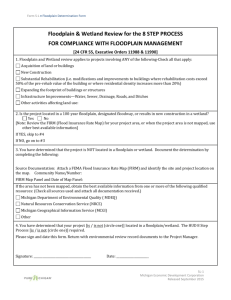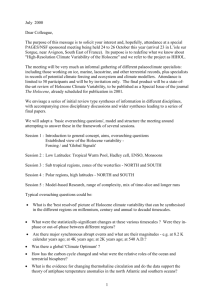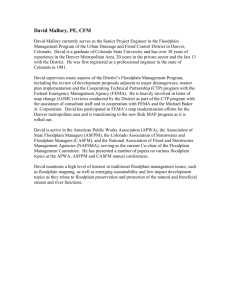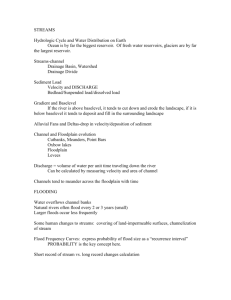Mark Gonzalez, Riparian Ecologist (Soils)
advertisement
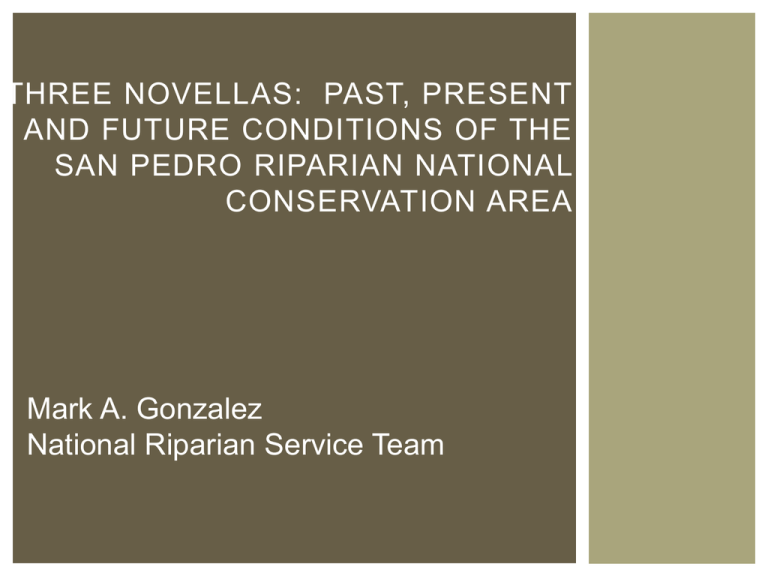
THREE NOVELLAS: PAST, PRESENT AND FUTURE CONDITIONS OF THE SAN PEDRO RIPARIAN NATIONAL CONSERVATION AREA Mark A. Gonzalez National Riparian Service Team OUTLINE Past, Present and Future Conditions of the San Pedro Riparian System Novella 1: Once Upon a Time – Holocene history of the SPRNCA Novella 2: Flower Power – Everything you needed to know about plants but were afraid to ask Novella 3: Making a Better Sponge – Processes that store and release water along the San Pedro River INTRODUCTION Project Area San Pedro Riparian National Conservation Area International border to St. David SPRNCA boundary (from Hereford 1993) NOVELLA I: ONCE UPON A TIME – HOLOCENE HISTORY OF THE SPRNCA HOLOCENE SETTING Piedmont/Fan Inner Valley Basin Fill Basement Rock HOLOCENE SETTING Inner Valley Pre-entrenchment Landforms Entrenchment Landforms HOLOCENE SETTING Weik Ranch Mbr. 6500-4300 yrs BP (Qwk) Hargis Ranch Mbr. 3500-2000 yrs BP (Qha) McCool Ranch Mbr. 2000 BP to AD 1880 (Qmc) Teviston alluvium (Qtv) Little Ice Age (AD 1450-1850) paleosol Qmc-B Qmc-B Qha Qmc-A Qwk Qmc-A Historic 1900 yrs BP 2600 yrs BP 4000 yrs BP 7500 yrs BP Sources: Haynes 1987; Hereford 1993; Waters and Haynes 2001 HOLOCENE SETTING: M C COOL RANCH PALEOSOL 1 mi S Summers Wells Qtv Garden Wash ¼ mi N of Casa de San Pedro Boquillas Wash ¼ mi S of Boquillas Wash Qtv Qtv Qtv Qtv Qmc Qmc Qmc Qmc Qmc HOLOCENE SETTING: M C COOL RANCH PALEOSOL Physical Conditions Little Ice Age (AD 1450-1880) Qtv Low-energy environment Shallow depth to water table Qmc High organic-matter content (esp. from paleo-cienega) Water storage and release patterns PRE-ENTRENCHMENT CONDITIONS Biological Conditions Widespread cienega formation Herbaceous dominated communities PERIOD OF ENTRENCHMENT Timing (1880s-1910s +/-, Hereford 1993) Downstream initiation (1882, Contention area) Upstream migration (1908 – Hereford Bridge) Spread into and up tributary drainages San Pedro River Pre-entrenchment channel: Shallow Post-entrenchment channel: Deep CHANNEL EVOLUTIONARY SEQUENCE t 1 Stable channel t 2 Downcutting t 3 Widening t 4 Aggradation t2 t1 stable t3 widening t1 t2 downcutting t3 t4 aggradation SUMMARY Stream valleys evolved naturally throughout the Holocene Period in response to climatic fluctuations. Aggradation (valley filling) coincident with wet/cool periods and high water tables Channel incision and sediment removal coincident with dry/warm periods Qmc-B Qmc-A Qmc-B Qha Qwk Qmc-A Sources: Haynes 1987; Hereford 1993; Waters and Haynes 2001 SUMMARY Channel Evolutionary Sequence: SPR in ‘infancy’ t1 t2 Stable channel Downcutting t 3 Widening t 4 Aggradation t2 t1 stable t3 widening t1 t2 downcutting t3 t4 aggradation NOVELLA II: FLOWER POWER -EVERYTHING YOU EVER WANTED TO KNOW ABOUT PLANTS BUT WERE AFRAID TO ASK PAST –PLANT COMMUNITIES Channel + Terrace Floodplain/Cienega Perennial Flow • Obligate wetland plants: Hardstem and threesquare bulrush; flatsedge; cattail, PAST –PLANT COMMUNITIES Terrace Channel Floodplain/Cienega Perennial (water-table < 20 ft depth) • FACW plants: Sacaton; bunchgrass/shrub; mesquite (+/dependent on fire regime) PRESENT – PLANT COMMUNITIES Holocene Terraces Terrace Perennial Reaches Obligate, and facultative wetland species: hardstem and threesquare bulrush; cattail; spikerush; horsetail, and seepwillow Channel Floodplain PRESENT – PLANT COMMUNITIES Holocene Terraces Terrace Channel Floodplain Intermittent Reaches Johnsongrass, Bermudagrass, seepwillow, and minor occurrences of hydric herbaceous species PRESENT – PLANT COMMUNITIES Holocene Terraces Channel Terrace Perennial Reaches Fremont cottonwood / Goodding’s willow; Baccharis, with lesser amounts of netleaf hackberry, mulberry, grama grasses Floodplain PRESENT – PLANT COMMUNITIES Holocene Terraces Channel Terrace Floodplain Intermittent Reaches Fremont cottonwood / Goodding’s willow; xeric woody shrub (AZ ash and walnut, hackberry) with tamarisk/; baccharis and herbaceous understory PRESENT – PLANT COMMUNITIES Holocene Terraces Terrace Perennial Reaches Sacaton – Mesquite continuum Sacaton dominated with frequent fire Mesquite dominated with fire suppression Channel Floodplain PRESENT – PLANT COMMUNITIES Holocene Terraces Terrace Channel Floodplain Intermittent Reaches Increase in woody shrubs and decrease in herbaceous plants Facultative plants more common than hydric plants SUMMARY Holocene Terraces Terrace Channel Floodplain Plants in and near the riparian zone ‘ stratify’ themselves by: Depth to water Permanence / seasonality of water (i.e., Perennial vs. Intermittent flow) NOVELLA III: MAKING A BETTER SPONGE – STORING AND RELEASING WATER WATER STORAGE: BANKS I Standard Form II Ponded Form III Tributary Fan Form IV Adjustment Form (I) (IV) (I) (III) (II) WATER STORAGE: BANKS When stage (water level) is high in the channel, water is forced (pushed by hydrostatic pressure) into the banks and stored in the floodplain alluvium. When stage falls in the channel, the hydraulic gradient is reversed and water flows out of the banks and into the channel to supply baseflow between high-flow events WATER STORAGE: BANKS Ponded water moves out of channel and into banks during high stage. Stored water also moves down valley with the hydraulic gradient. (I) (IV) (I) (III) (II) WATER STORAGE: FLOODPLAIN Floodplain recharge has greater surface area than channel-bank recharge alone. This permits more water to enter alluvial aquifer in short time. WATER STORAGE: FLOODPLAIN ROUGHNESS To increase floodplain infiltration, Floodplain vegetation must decrease water velocity VEGETATION RESPONSE Grazing closure in 1988 (< 25 years ago) has allowed riparian vegetation to establish and grow. View from Hereford Bridge: (left) circa mid-1980s (BLM); (right) 10 years later (photos by D. Krueper, BLM) WATER STORAGE: TRAPPED SEDIMENT WATER STORAGE: TRAPPED SEDIMENT AND ORGANIC MATTER 195 lbs H2O Water Holding Capacity of Soil Organic Matter Pounds H2O in 100 Pounds of Soil 200 160 140 lbs H2O 120 100 lbs H2O 80 55 lbs H2O 40 33 lbs H2O 1 (modified from Carpenter) 2 4 3 Percent Organic Matter 5 LOSS OF WATER STORAGE 4200 ft 4100 ft Inner Valley Pre-entrenchment alluvium West East V.E. = 100X 0 0.5 1 1.5 0.5 km 1 Miles Available water volume in SPRNCA pre-entrenchment alluvial aquifer (WVa) composed of silt loam: WVa = (448 acres/mile X 40 miles) X 20 ft thickness X 1.7”/ft ÷ (12”/ft) WVa = 50,000 acre-feet Pre-entrenchment alluvial aquifer (with 3’ thick cienega soil on 3600 acres (1/5 of riparian area) and MODEST 5% organic matter): WVa = 50,000 acre-ft + (16,000 gallons X 5 X 3’ X 3600 acres) ÷ (325,851 gals./acre-ft) WVa = 50,000 acre-ft + 2650 acre-ft = 52,650 acre-ft LOSS IN WATER STORAGE 4200 ft Inner Valley West East Post-entrenchment alluvium 4100 ft V.E. = 100X 0 0.5 1 0.5 1.5 km 1 Miles Available water volume in SPRNCA for post-entrenchment alluvial aquifer (WVa) composed of sand: WVa = (128 acres/mile X 40 miles) X 10 ft thickness X 0.9”/ft ÷ (12”/ft) WVa = 3840 acre-feet St David 14 Escalante 13 St David 12 Smrs-Cnt’n 11 Tombstone 10 Depot 9 Fairbank 8 Boquillas CONTROLS ON PERENNIAL FLOW Reaches 9-10 Predominantly Intermittent 7 Charleston 6 Escapule Hwy 90 5 Lewis Spr. 4 Cottonwood 3 Hunter 2 HerefordKolbe Hwy 92 1 Palominas Reaches 1-8 Predominantly Perennial 14 13 12 11 10 9 8 7 6 5 4 3 2 USA AZ MEX SN 1 Reaches 1-4 Perennial: Underlain by restrictive siltclay layers Reaches 5-8 Perennial: Gaining reaches with water upwelling on the east side of the silt-clay restrictive layer Reaches 9-14 Intermittent: Bedrock controlled or smaller basin contributions Elevation, ft above sea level 7500 East West 6000 4000 2000 3 miles 3 Miles 4000 3000 Elevation (ft amsl) Palominas Hereford Cottonwood Lewis Spring Charleston gage Boquillas Fairbank North South SUMMARY: CHANGE IN WATER STORAGE 4200 ft Inner Valley West East Post-entrenchment alluvium 4100 ft V.E. = 100X 0 0.5 1 0.5 1.5 km 1 Miles Pre-entrenchment estimated available water storage: 50,000 acre-ft Post-entrenchment estimated available water storage: 4000 acre-ft SUMMARY Bigger sponges store more water--Sponges get bigger as: Vegetation covers riparian area Vegetation slows stream velocity and enhances infiltration Vegetation / organic matter is trapped in sediment Bottom Line: More vegetation = more water storage SUMMARY Bigger sponges store more water--Sponges get bigger as: Sediment accumulates and aggrades on floodplain Floodplain widens Floodplains are inundated Tributary mouth fans (and beaver) pond water Bottom line: More deposition = more water storage SUMMARY Continued improvement in riparian conditions is dependent upon seasonal timing of streamflow, adequate runoff volume and sediment load, and unrestrained floods. Factors that reduce runoff volume, increase salinity, change runoff seasonality, or reduce sediment loads are detrimental to the riparian community (Hereford, 1993). Protection of both the flow and the sediment regime of this river are crucial to its survival.





